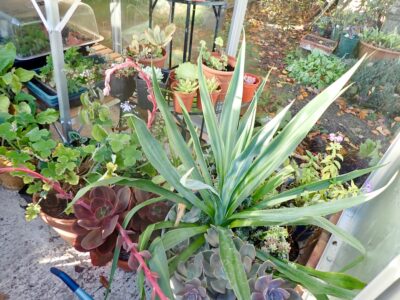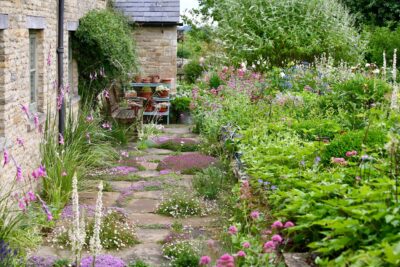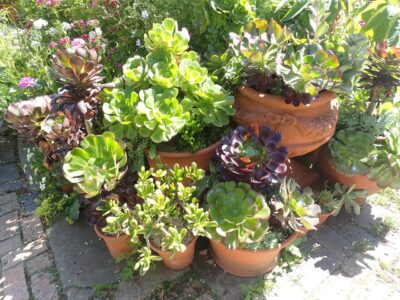
If there’s one plant at the height of the fashion stakes, it’s the succulent. We can’t get enough of these fleshy-leaved beauties with their intricate swirls and whorls. They’re on countless nursery stands, at all the major flower shows, and they’re found in every garden centre across the land. And rightly so, for these easy-care plants are adaptable plant sculptures. They can be grown outside in summer, in mixed containers or individually, and they also make great house plants. They won’t shed needle-pricking thorns. like the cacti of my childhood, although some of them might have very sharp tips!
I started getting interested in succulents some twenty years when I was still making annual trips to the Barakura Garden in Japan every June. This English style garden, created by Kay Yamada, is on the Tateshina Plateau in an area of Honshu known as the Japanese Alps. Nagano, the Japanese prefecture, hosted the Winter Olympics in 1998 and the Japanese visit this area, skiing in winter and taking onsens – bathing in the hot volcanic waters – at other times. It’s a short train ride away from the bustle of Tokyo so this area’s popular all year round.
The Barakura Garden’s Midsummer Flower Show attracts gardeners and ladies who lunch. The Japanese love their gardens as much as their wild spaces. However, garden space is limited in cities and towns, so they go for small and intricate. Succulents are widely popular, because they cope with the Japan’s summer heat and city pollution. Specialist nurseries attending the show sold lots of different miniature rosettes ready to pot up. Being light in weight, visitors could carry back twenty or so in a small box.

I drooled over the tiny plants every year, but couldn’t buy any for obvious reasons. They were British customs at airports and plant security. We shouldn’t bring plants in: it’s illegal. When I left the show one year, I was given a beautifully wrapped gift box and assumed it was Japanese sweets. I enjoy Japanese food with one exception. I loathe Japanese sweets, which are sweet and pappy to my taste. When I got back home, I relegated the beautifully wrapped box to the sideboard and forgot about it for months. One hungry evening, I explored the package and was amazed to find twenty-four different miniature rosettes of succulents! I decided not to eat them. I grew them instead, for they were still in good condition. Please do not report me to the Plant Police!
I’ve still got one or two of those original rosettes, but I’ve learnt a lot more since then. I’ve found, for instance, that succulents prefer a bright position to a sun-baked one. Many are quite cold-tolerant, because they come from arid areas of the word where the days are hot and the nights are colder. If you keep your succulents dry and frost-free in winter, they survive, and they make perfect winter additions to the cool Hartley greenhouse. Mine reside there in the winter, hopefully without vine weevil!
Succulents are probably the easiest thing in the world to propagate, because most will grow from a single leaflet plunged into coarse horticultural sand that’s kept damp to the touch. Once roots appear, they can be potted up into gritty compost. This ease of propagation is probably part of their attraction to nurserymen and women and several specialist nurseries have now moved into them. They include Simply Succulents, Surreal Succulents, W & S Lockyer and Old Court Nurseries. They’re growing some exciting new things, because there’s a lot of plant breeding going on. These can be pricey, but most succulents will cost you about £4.00 on average.
Personally, I prefer the non-savage succulents, so if I see the word agavoides as a second or species name, I walk away. It’s probably going to have sharp tips on the ends of every leaf. Thankfully most echeverias are harmless and they produce soft rosettes in different colours and forms. Most produce offsets round the main rosette, in a ‘hen and chickens’ way, so they creep across pots and form humps and mounds.
Echeverias come from semi-desert areas of Central America, Mexico and north western South America, so they are drought-resistant. However, they look extra ‘plumptious’ when watered. Always allow the water to drain away because they hate standing in water and thye’ve done a lot of that this year. It’s hardly stopped raining here. Echeverias can look shabby in winter, but they soon recover in spring. ‘Black Knight’ has dusky foliage and the flowers are bright-red. ‘Nicholas Bravo’ has glaucous plump leaves edged and centred in red. ‘The Duchess of Neuremberg’ has pinkish-grey foliage. There are lots of offer.
Aeoniums, which are native to parts of northern Africa and nearby islands, including the Canary Islands, Cape Verde Islands and Madeira, vary in habit. The tree-like Aeonium arboreum forms on tall stem with several rosettes at the top. The most well-known is an almost black-leafed hybrid named ‘Zwartkop’ (‘Schwartzkopf’). Foliage colour lightens up during winter sometimes.

The sooty, high-gloss foliage creates a contrast with other succulents, which tend to grey or pink-toned. The taller ones add height to a mixed container. There are plenty of aeoniums on offer. ‘Medusa’ has red-edged dark rosettes and ‘Velour’ is another dark one, although bushier and shorter. ‘Voodoo’ is a mint-chocolate combination of dark foliage surrounding a darkly margined vivid-green middle. I have to keep a grip on the purse, when I see them!
Aeoniums have been crossed with hardier house leeks, also known as sempervivums, to produce hardier hybrids known as x Semponium. In 2022, one called ‘Destiny’ won the RHS Plant of the Year at The Chelsea Flower Show. It was bred by Daniel Michael, the founder of Surreal Succulents, and it was a difficult task because aeoniums flower in spring, whilst Sempervivums do so in the summer months. A lot of greenhouse juggling went on. Although ‘Destiny’ has hardy Sempervivum or house leek in its bloodline, the foliage of this hybrid is quite soft. It’s said to be hardy to -2C, but I haven’t tested out the theory.
Crassulas, which come from South Africa and Mozambique, vary in form. ‘Buddha’s Temple’, which is a study in green geometry, resembles an oriental temple roof. Others have tiny bead-like leaves, mainly in jade-green or pink, and these infill spaces in mixed arrangements. Some, like the money plant or Crassula ovata, make huge man-high plants in time. Put them outside in summer, but bring them into the house in winter, because crassulas need year-long warmth. Crassula ovata ‘Monstruosa’, sometimes called ‘Hobbit’, is rather like a compact bonsai. The leaves are tubular and, in full growth, it resembles a coral reef.
The plumpest, roundest leaves of all belong to a Mexican native, Pachyphytum oviferum or the sugar almond plant. It’s also called Moonstones, because the opalescent leaves resemble this semi-precious stone in colour. I’ve discovered, in the worst possible way, that the sugar almond plant needs warmth throughout the year. If your greenhouse is only slightly heated, bring this one indoors, or you’ll lose it like I did!
There’s a lovely one, with more pointed opalescent pink leaves, called ‘Rosy Crow’. Love the name and this one’s been sold by W & S Lockyer. If you’re thinking of buying, wait until late spring. The range will be better and your new plant will get off to a flying start.
Whichford Pottery in Warwickshire is one of the best places to appreciate succulents in pots and there are plenty of pots to buy as well. I hold on to my purse there as well. In summer I admired a simple arrangement of specimen succulents arranged on a wrought iron garden table. They provided a mixture of frilly, ruched edges, bowl-shaped rosettes and upright arms. John Massey’s private garden at Ashwood Nurseries in Staffordshire provides a masterclass with agaves, aeoniums and many other succulents. They rub shoulders with vivid salvias, fuchsias and begonias. John’s plants are overwintered in his wonderful Hartley greenhouse. Please check opening times – look for John’s Garden www.ashwoodnurseries.com











